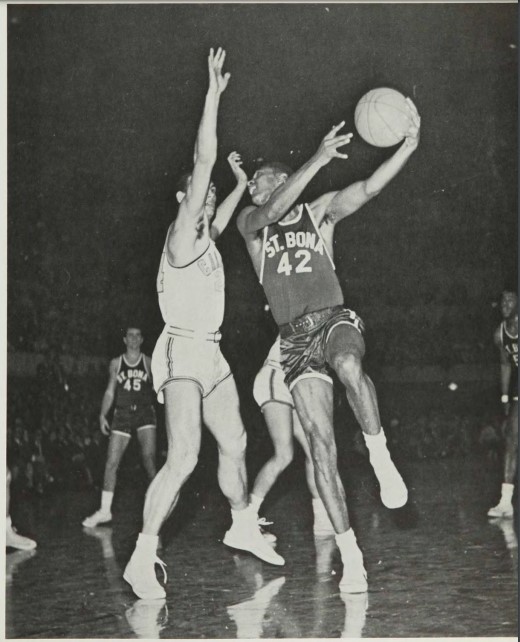
My wife has never watched a St. Bonaventure (SBU) men’s basketball game, but she deserves an assist on leading me to learn more about the loss that effectively ended the hopes of an NCAA championship on a gloomy St. Patrick’s Day in 1961.
Her directive to me was clear: In preparing to move, my childhood boxes collecting dust in the basement needed to be sorted out. Combing through them uncovered an array of Bona gems. I found the Bob Lanier autograph taken to my first grade class in 1968. Of course I had kept the copy of The Olean Times Herald on the day after SBU beat Houston for the 1977 NIT championship. Eastern 8 newspapers? Yes, I had them, too, not to mention a collection of Bona game programs from my time as a sports information intern in the early 1980s.
Then there was an unusual item, something related to a Bona defeat to Wake Forest College—its name at that time—in March 1961. How it found its way into my assortment of memorabilia was a mystery. After all, the game was played a month before I was born, well before I remember listening to Don McLean call games as a kid. I knew the Bonnies had some good teams in the pre-Lanier era, but knew nothing about the 1960-1961 squad and wondered about this particular loss.
Yes, Wake Forest upset St. Bonaventure on March 17, 1961, in the NCAA Eastern Regional semifinal game before a capacity crowd of 12,000 in Charlotte, NC, a profound disappointment to Bona fans thinking about a national championship. After all, this first visit to the NCAA tournament featured a Bona team ranked as high as second in the country that season. The final AP poll placed St. Bonaventure at #3 in the country, two spots behind the NCAA champion Ohio State team that featured Jerry Lucas, Larry Siegfried, Mel Nowell, John Havlicek, and Bobby Knight.
In fact, the Bonnies accepted the NCAA bid a month before the tournament started. According to a Sports Illustrated account from February 1961, St. Bonaventure was the first independent team chosen for the 1961 NCAA tournament. Called the best team in the East, the story related that the “enterprising” Bonnies could get a rematch against Ohio State, the only team to beat them to that point in the season. That Madison Square Garden tilt on New Year’s Eve 1960 found the Bonnies down by 11 points in the second half before losing, 84-82.
Niagara and Duquesne upended St. Bonaventure toward the end of the regular season with the consecutive setbacks occurring within five days of each other. The Niagara loss in the Olean Armory ended SBU’s 99-game home winning streak that dated to 1948, while the Dukes upset the Bonnies in overtime, 79-74, in Pittsburgh.
The first round of the NCAA, played as part of a tripleheader before 18,000 fans in Madison Square Garden, saw the Bonnies rally over Rhode Island. Tom Stith, the two-time All-American and runner-up national player of the year that season, scored 34 points, while Freddie Crawford added 29 points. The New York Times account described the Bona duo as the “most dazzling practitioners” among the six teams that day in playing with “startling acrobatics.”
The 78-73 setback to Wake Forest in the NCAA East Regional semifinals at the Charlotte Coliseum was unique from the outset. Billy Packer, the famed Wellsville (NY)-born television analyst who covered 34 consecutive Final Fours, wouldn’t have been courtside at that point. He actually played in the game. The 5-9 junior guard for the Demon Deacons averaged 17 points per game, but wasn’t the scoring leader for the squad. That achievement belonged to the star 6-8 forward Len Chappell—the Tom Stith equivalent for Wake Forest—who had a 27 point per game average. Though growing up closer to Olean than to Winston-Salem, Chappell took his high school experience from a small town near Johnstown, PA, to become a two-time ACC Player of the Year.
The game was also unique in a way likely unmatched in any NCAA game since 1961. It highlighted two players who went on to become the second picks in the first round of a professional draft. Stith, a subsequent Hall of Fame inductee at St. Bonaventure, was chosen as the second overall pick of the 1961 draft by the New York Knicks, while Washington selected Wake Forest player Norm Snead as its quarterback in the second spot of the NFL draft the very same year.
Ahead 37-36 at halftime, the Bonnies faced a persistent Wake Forest team that forced six lead changes in the second half. Bob Woollard, a 6-10 center later drafted by the New York Knicks, scored 10 points and grabbed 11 rebounds off the Wake Forest bench to contribute to the Demon Deacon win. Woollard averaged just four points per game that season, yet his performance against St. Bonaventure was pivotal in dashing NCAA championship dreams.
The referees were no doubt busy in the 40 minutes of play, though the game must have been far longer. Each team shot 34 free throws with Wake Forest sinking five more than Coach Eddie Donovan’s squad. Three of the seven Bona players fouled out as the team committed a season-high 24 fouls. In addition, only five baskets were scored from the field by both teams in the final nine minutes of regulation. The 73-point output by St. Bonaventure was the lowest of the season.
Both The Bona Venture and Olean Times Herald reports of the game referred to numerous traveling infractions called against the Bonnies. In the latter story, Coach Donovan conceded, “We were called with an unusually large number of traveling violations, but I guess we were traveling.”
The Bona defeat was also mentioned in a 1968 Sports Illustrated story by Curry Kirkpatrick, who described it as “a game still remembered for its odd officiating and for a Wake Forest fast break started by the coach from his bench.” That specific second-half play, as related in an article years later in The Buffalo News, had the Wake Forest coach taking the ball from one of the Bona guards, who was about to offer an in-bounds pass, and throwing it to Packer for a basket. A post-game commentary in The Bona Venture concluded, “When a coach is allowed to pass the ball into one of his players and this results in a score for his team, it is apparent that the officials either don’t care or are blind—or both.”
On top of this, a story in the Charlotte Observer referred to a clock malfunction in the scoreboard in the final minutes of regulation, leading to “anxious inquiries about the time remaining.”
Wake Forest lost its next game, the Eastern Regional finals, to a Jack Ramsay-coached St. Joe’s team. For St. Bonaventure, there would be no rematch against Ohio State, which eventually suffered an overtime loss to Cincinnati in the NCAA championship game. Stith, who passed the 2000-point mark in the subsequent consolation victory over Princeton, saw his spectacular career at St. Bonaventure come to an end, and, just two months after the Wake Forest loss, Donovan accepted a head coaching position with the New York Knicks.
The new Bona coach, 24-year-old Larry Weise, inherited the team later that year. His success in the ensuing seasons propelled the program to new heights, which prompted kids like me to become ardent Bona fans and to keep special memories in all kinds of ways for decades to come.
